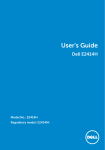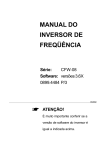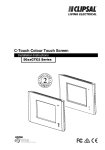Download MPC F1925 User`s guide
Transcript
F1925 LCD Monitor User’s Guide Table of Contents User’s Guide........................................................................3 Packing List.........................................................................3 Safety Information ..............................................................3 LCD Monitor Features ........................................................5 Setup Instructions ..............................................................6 Monitor Base ......................................................................................... 6 Power Cord and Power Adapter ........................................................... 6 Video Cables ......................................................................................... 8 Adjusting the Viewing Angle..............................................8 Operating Instructions .......................................................9 General Instructions .............................................................................. 9 Front Panel Controls ............................................................................. 9 Accessing the Adjustment Controls .................................................... 10 Adjusting the Picture ........................................................................... 11 Cleaning the Monitor ........................................................................... 13 Monitor Drivers .................................................................13 Warranty Information........................................................14 Features .............................................................................14 Energy Star Standards........................................................................ 14 Plug & Play DDC1/2B Feature ............................................................ 14 Appendix A — Troubleshooting ......................................15 Appendix B — On-Screen Messages ..............................17 Appendix C — Factory Preset Timing .............................18 Appendix D — VESA Mounting........................................19 Appendix E — Connector Pin Assignment.....................20 Appendix F — Acceptable LCD defects ..........................21 Appendix G — Monitor Specifications............................22 Appendix H — FCC Notice ...............................................24 2 USER’S GUIDE This user’s guide provides important information about operating your monitor. Before using the monitor, please read this guide thoroughly and then save it for future reference. PACKING LIST Before setting up and using your monitor, examine the items in the monitor package. If anything is missing or damaged, please contact MPC immediately. Look for the following items: • • • • • • • 19” LCD Monitor F1925 LCD Monitor User’s Guide 100/120 VAC rated Power Cord External Power Adapter Brick (12 VDC) Monitor Base DB-15 Analog video cable DVI-D Digital video cable Note: Save the original shipping carton and packing materials for transporting your monitor in the future. If you transport the monitor over long distances, completely repackage the monitor in its original packing material. SAFETY INFORMATION • Do not use the monitor near standing bodies of water or in humid envirionments. • Set the monitor on a flat, stable surface. Do not place it on an unstable cart, stand, or table. If the monitor falls, it might injure a person and/or cause serious damage to the monitor. • When placing the monitor on a cart or stand, use only a cart or stand recommended by the manufacturer or sold with the monitor. If you mount the monitor on a wall or shelf, use a mounting kit approved by the manufacturer and follow the kit instructions. • Slots and openings in the back and bottom of the monitor are provided for ventilation. To ensure reliable operation of the monitor, and to protect it from overheating, these openings must not be blocked or covered. Do not place the monitor on a bed, sofa, rug, or similar surface. This monitor must never be placed near or over a radiator or heat register. This monitor must not be placed in a built-in enclosure of any kind unless proper ventilation is provided. 3 • The monitor must only be connected to the AC power source as indicated on the label. If you are unsure of the type of AC power available, ask your local power company. Only connect this monitor to a power outlet that matches the power requirements of this monitor. • The monitor is equipped with a three-prong, grounded plug (a plug with a third pin for grounding). For safety purposes, this plug will only fit into a grounded power outlet. If your outlet does not accommodate the three-wire plug, have an electrician install the correct type of outlet, or use an adapter to ground the appliance safely. • During a lightning storm, unplug the monitor. Also unplug the monitor when it will not be used for a long time. This will protect the monitor from damage due to power surges. • Do not overload power strips and extension cords. Overloading power strips and extension cords can result in a fire or electric shock. • Never push objects of any kind into the monitor through openings. The objects could touch dangerous voltage points or short out parts, possibly resulting in an electric shock or a fire hazard. • Never spill liquid of any kind on the monitor. If this occurs, disconnect from the power source immediately. • Do not attempt to service the monitor yourself. Opening or removing the monitor’s cover can expose you to dangerous voltages and other hazards. Please refer all servicing to qualified service personnel. • To ensure satisfactory operation, only use the monitor with UL listed computers that have the appropriate configured receptacles marked between 100–240 VAC, Min. 3.5A. • Do not allow anything to rest on the power cord. Do not place the monitor where people might walk on the cord. • Do not place the monitor in direct sunlight, or where it is near excessive dust, mechanical vibration, or shock. • This monitor is for use only with the included power adapter (output 12Vdc) that has a UL CSA listed license. Warning: To prevent a fire or shock hazard, do not expose the monitor to rain or moisture. Dangerously high voltages are present inside the monitor. Do not open the monitor cabinet. Refer servicing to qualified personnel only. Warning: Keep all packing materials away from children. 4 LCD MONITOR FEATURES • • • • • • 19-inch (48.0 cm) TFT Color LCD Monitor 75 mm x 75 mm VESA Mounting Pad (removable base) EPA ENERGY STAR® Ergonomic Design (MPRII Approved) Space Saving, Compact Case Design Dual Input – Analog and Digital The following occurrences are normal with an LCD monitor and do not indicate a problem. • Due to the nature of the internal fluorescent backlights, the screen may flicker during initial use. If this occurs, turn off the monitor and then turn it on again, making sure the flicker disappears. • You may find slightly uneven brightness on the screen depending on the desktop pattern you use. • The LCD screen has an effective pixel count of 99.99% or more. It may include blemishes of 0.01% or less, such as a missing pixel or a pixel lit all of the time. Refer to Appendix F – Acceptable LCD Defects for additional details. • The life of the internal fluorescent backlights used in the LCD monitor is approximately 10,000 hours. Contact MPC technical support or an authorized dealer for a replacement when the screen is dark, flickering, or not lighting up. Never attempt to replace the light yourself. Refer servicing to qualified personnel only. 5 SETUP INSTRUCTIONS The following sections provide information about attaching the base to your monitor and using the power cord and video cable. Monitor Base To install the monitor base, place the monitor in the base until it snaps into place. To remove the monitor base, gently turn the monitor upside down and press the four retention clips apart to release the base. Pull the base straight away from the monitor. See Figure 1 below. Install Remove Figure 1: Installing and Removing the Monitor Base Power Cord and Power Adapter Before connecting your monitor’s power cord and adapter, read the guidelines below: • Use only the Power Adapter included with your monitor. One of the two Power Adapters listed below should be included. You will find the following markings on the Power Adapter included with your monitor: • • 6 Manufacturer: Polaris Electronics (Dong guan) Co; Ltd. (CHI SAM) Model: CH -1205 Output: 12 VDC 5 A Manufacturer: TPV Electronics (FUJIAN) CO., LTD Model: ADPC-12V Series Output: 12 VDC 5 A • This monitor has a universal power supply. It can operate in either a 100/120 VAC or 220/240 VAC voltage area (no user adjustment is required). • Make sure the power cord meets the specifications and requirements for your area. The power cord included with your monitor is rated for 100/120 VAC. To connect the power cord to your monitor and a power source, follow the steps below: Caution: If the AC outlet is not grounded (with three holes), install the proper grounding adapter (not supplied). 1 Plug the AC power cord into the supplied external power adapter brick. Plug the small end of the power adapter cord (DC Plug) into your monitor’s power input socket (DC Jack). See Figure 2. Figure 2: Connecting Cables 2 Plug the other end of the power cord into a three-pin AC power outlet or a UL-approved power strip. Note: A certified power supply cord must be used with this equipment. The relevant national installation and/or equipment regulations need to be considered. A certified power supply cord not lighter than ordinary polyvinyl chloride flexible cord according to IEC 60227 (designation H05VV-F 3G 0.75mm or H05VVH2-F2 3G 0.75mm) should be used. As an alternative, a flexible cord of synthetic rubber, according to IEC 60245 (designation H05RR-F 3G 0.75mm), can be used. 7 Video Cables The monitor comes with separate video cables for analog and digital connections. The cable you choose to use will depend on the input type you select. The analog cable has a blue 15 pin connector at each end. The digital cable has a white 24+ pin connector at each end. Caution: Do not bend the signal cable excessively, or you might break the wires inside the cable. 1 2 Plug the video cable connector (see Figure 2 on page 7) into the computer's video port, taking care not to bend any pins on the connector. Tighten the two screws on the video connector with your fingers to secure the connection. Note: Over-tightening this connection can damage the monitor cable or your computer’s video card. ADJUSTING THE VIEWING ANGLE • For optimal viewing, look at the full face of the monitor, and then adjust the monitor’s angle to your own preference. • Hold the base so the monitor does not fall when you change the monitor’s angle. • You are able to adjust the monitor’s angle from -5° to 25°. 25 -5 Figure 3: Adjusting the Monitor’s Angle Caution: Do not touch the LCD screen when you change the angle, or the screen may become damaged or broken. Warning: Be careful not to pinch your fingers when adjusting the monitor’s angle. 8 OPERATING INSTRUCTIONS The following sections provide information about operating and adjusting your monitor. General Instructions To turn on the monitor, do the following: 1 2 3 4 Check that the power supply is connected to the monitor and a power outlet or socket. Check that the video cable is connected to your computer’s video port. Locate the power button (see figure and table on page 10). Press the power button. The power indicator will light up. The monitor features a unique quick-switch system, so a picture should appear within seconds after the monitor is turned on. Front Panel Controls The power button is located on the right side of the front panel of the monitor as you are facing it. The buttons above the power button are for adjusting the monitor’s picture and accessing the OSD. See the figure below and the table on page 10 for the layout and names of the control buttons. Figure 4: Control Buttons 9 Table 1: Control Buttons Descriptions Feature 1 Auto Config/Exit Description The Auto Config button is used to automatically set the H-Pos, V-Pos, Clock, and Focus. Press and hold this button for 2 seconds to begin the auto config cycle. The Auto Configuration function is disabled when the digital input is selected. This adjustment is not necessary with a digital source. This also acts as the Exit button. Press it to close the OSD menu. This will also back out of a menu selection. 2 Brightness / 3 Contrast / Press this button to adjust your monitor’s brightness. If the OSD is open, this button will move through the selections in a clockwise direction. Press this button to adjust your monitor’s contrast. If the OSD is open, this button will move through the selections in a counter-clockwise direction. 4 Menu/Enter 5 Power Indicator 6 Power Button Press this button to open the On Screen Display (OSD) menu or to select an adjustment icon within the OSD. Power Indicator: Green = power on mode (normal operation) Orange = low power mode (low power consumption; no picture) Press this button to turn the monitor on and off. Accessing the Adjustment Controls The following list explains how to access and use the adjustment controls appearing in the On Screen Display (OSD) Main Menu: 1 2 3 4 10 Press the Menu button to make the OSD window appear. The menu will look like Figure 5. or buttons to select the desired function. Press the Press the Menu button to select the function that you want to adjust. or buttons to change the settings of the current Press the function. • When the OSD window is active, it shows the input signal timing. The H stands for the horizontal frequency and V for the vertical frequency. • To exit and save, select the exit functions, or leave the monitor alone for 10 seconds. To adjust any other function, repeat 2-4. H:60KHz R V:75KHz Contrast G 70 B EXIT R C1 C2 Figure 5: On Screen Display (OSD) Menu Note: If you do not make any OSD menu adjustments or selections for more than 10 seconds, the current setup will be saved, and the OSD will disappear automatically. Adjusting the Picture The table below describes the functional control icons that appear on the OSD menu. Table 2: Functional Control Icons Function Contrast Icon Description Use this function to adjust the picture’s contrast. Brightness Use this function to adjust the picture’s brightness. Focus Use this function to adjust the picture’s focus. The Focus adjusts the phase of the pixel clock signal. With a wrong phase adjustment the picture has horizontal disturbances or lines in a bright picture. Use this function to adjust the picture’s clock. The Clock (pixel frequency) controls the number of pixels scanned by one horizontal sweep. If the frequency is not correct, the screen shows vertical stripes and the picture will not be the correct width. Clock 11 H-Position Use this function to adjust the picture’s horizontal position. Use this function to adjust the picture’s vertical position. V-Position Input Select Use this function to select analog or digital input. When Digital is selected the following controls will be disabled: Clock, Phase, HPosition and V-Position. These adjustments are not necessary with a digital source. Use this function to select which language the monitor will use to display the instructions. Use this function to switch scaling modes on this display. They are as follows: Language Picture Scaling Warm Color C1 Cool Color C2 Reset 12 • Full Mode performs anti-aliasing on the offnative resolutions it supports while stretching the picture horizontally and vertically to fill the full screen. At this setting some picture distortion may occur. • Aspect Mode performs anti-aliasing on the off-native resolutions it supports while stretching the picture horizontally to fill the width of the screen. At this setting picture distortion should not occur but some of the display area may not be used leaving black bands at the top and bottom. • Native Mode, as the name implies, displays the picture in the actual pixel for pixel native format. The 1024 x 768 uses exactly 1024 pixels horizontally and exactly 768 pixels vertically and no anti-aliasing occurs. The picture is placed in the center of the display area. This will leave blank area bordering the picture displayed. Selecting this option sets the color to a warm white setting. This setting has more red than the C2 setting and is better for viewing pictures. Selecting this option sets the color to a cool white setting and is better for viewing text. This setting has less red than the C1. Use this function to restore factory conditions. Exit Blue Green Red Use this feature to save your selections and adjustments and to exit the OSD menu. Use this function to adjust the picture’s blue intensity. Use this function to adjust the picture’s green intensity. Use this function to adjust the picture’s red intensity. Cleaning the Monitor To keep the monitor looking new, periodically clean the monitor’s case with a soft cloth. As a safety precaution, always unplug the monitor before cleaning it. Stubborn stains on the monitor’s case can be removed using a damp, dust-free cloth and a mild detergent solution. Caution: Never use strong solvents, such as thinner, benzene, or abrasive cleaners, because these will damage the monitor. To clean the LCD screen, use a damp cloth; however, make sure the monitor has been turned off first. Never apply water directly to the LCD screen. Always apply the water to the cloth first, and then wipe down the screen. You can also purchase and use monitor wipes to clean the LCD screen. MONITOR DRIVERS During normal operation, your system will automatically detect your monitor, and Plug and Play drivers will automatically be installed. If your application requires a specific monitor driver and color matching profile, these can be downloaded from the MPC Technical Support Site at http://support.buympc.com/index.html. If you do not have Internet access, you may also call MPC Technical Support at (800) 877-8856 to request the files be sent to you. 13 WARRANTY INFORMATION In the unlikely event that you have a failure with your MPC monitor, you can contact MPC Technical Support at http://support.buympc.com/index.html. If you do not have Internet access, you may also call MPC Technical Support at (800) 877-8856. Technical Support will provide you with instructions for returning the failed monitor. FEATURES Energy Star Standards This monitor may appear to be non-functional if there is no video input signal. For this monitor to operate properly there must be a video-input signal. This monitor meets power management standards as set by the Video Electronics Standards Association (VESA) and/or the United States Environmental Protection Agency (EPA) and the Swedish Confederation Employees (NUTEK). This feature is designed to conserve electrical energy by reducing power consumption when there is no video input signal present. When there is no video input signal, this monitor, following a time-out period, will automatically switch to a low power consumption mode. This reduces the monitor's internal power supply consumption. After the video input signal is restored, full power is restored, and the display is automatically redrawn. The appearance is similar to a "Screen Saver" feature, except the display is completely off. The display is restored by pressing a key on the keyboard or clicking the mouse. Plug & Play DDC1/2B Feature This monitor is equipped with VESA DDC1/2B capabilities according to the VESA DDC STANDARD. These capabilities allow the monitor to inform the host system of its identity and, depending on the level of DDC used, communicate additional information about its display capabilities. The communication channel is defined in two levels: DDC1 and DDC2B. The DDC1 is a uni-directional data channel from the display to the host that continuously transmits EDID information. The DDC2B is a bidirectional data channel based on the I²C protocol. The host can request EDID information over the DDC2B channel. See “Appendix E — Connector Pin Assignment” on page 20 for connector pin assignments. 14 APPENDIX A — TROUBLESHOOTING If the following information does not successfully solve your issue, please visit the MPC Technical Support Site at http://support.buympc.com/index.html. If you do not have Internet access, you may also call MPC Technical Support at (800) 877-8856. Table 3: Troubleshooting Monitor Issues Issue The power indicator LED is not lit. Solution • Press the monitor power button once to see if the LED comes on. • Verify that the power cord is plugged in firmly and correctly. • Verify the PC system is Plug & Play compatible. • Verify the Video Card is Plug & Play compatible. • Check the DB-15 plug on the Video Cable for bent pins. • • Adjust the contrast and brightness controls. The picture bounces or a wave pattern is present in the picture. • Initiate the automatic calibration function by pressing the ‘Auto’ button. • Manually adjust the Clock and Focus controls for better picture. The power LED is on (orange), but there is no video or picture. • Maker sure the computer’s video card is completely seated in the slot. • Make sure the monitor’s video cable is properly connected to the computer. • Inspect the monitor’s video cable and make sure that none of the pins are bent. • Make sure the computer is operational by pressing the [Caps Lock] key on the keyboard while observing the Caps Lock LED. The LED should either turn on or off after you press the [Caps Lock] key. The monitor is not detected by the system when it is connected. The picture is fuzzy. Initiate the automatic calibration function by pressing the ‘Auto’ button. 15 • Your computer may be in a low power state. Move the system’s mouse and press several keys on the keyboard to wake the system. The monitor’s picture is missing one of the primary colors (red, green, or blue). The screen image is not centered or sized properly. The picture has color defects (white does not look white). The picture has poor brightness or contrast. • Inspect the monitor’s video cable and make sure that none of the pins are bent. • Adjust pixel frequency (Clock) and Focus, or press the Auto Config button. • Adjust the RGB color or select a color temperature. • The lifetime of the back-light is limited. After 10,000 hours of use, the luminance of the light may be reduced to half of its original value. Please send the monitor to an authorized service agent for service. There are horizontal or vertical disturbances on the screen. • Use a pattern with a repetitive dot pattern to manually adjust the Clock and Focus, or press the Auto Config button. 16 APPENDIX B — ON-SCREEN MESSAGES Table 4: On-Screen Messages Message “Cable Not Connected” “Input Not Supported” Action • Check that the signal cable is properly connected. If the connector is loose, tighten the connector screws. • Check the DB-15 plug on the video cable for bent pins or other damage. • Your system may be set outside the display mode range of the monitor. Verify you are using a compatable display mode. See Table 5. 17 APPENDIX C — FACTORY PRESET TIMING Table 5: Factory Preset Timing Digital and Analog support are the same except where noted below. Standard Resolution DOS 640 x 400 31.469 kHz 70.0 Hz 720 x 400 31.469 kHz 70.0 Hz 640 x 480 31.470 kHz 60.0 Hz 640 x 480 35.000 kHz 72.0 Hz 640 x 480 37.500 kHz 75.0 Hz 640 x 480 43.200 kHz 85.0 Hz 800 x 600 35.156 kHz 56.0 Hz 800 x 600 37.879 kHz 60.0 Hz 800 x 600 46.879 kHz 72.0 Hz 800 x 600 49.725 kHz 75.0 Hz 800 x 600 53.674 kHz 85.0 Hz 1024 x 768 56.476 kHz 60.0 Hz 1024 x 768 60.020 kHz 70.0 Hz 1024 x 768 60.241 kHz 75.0 Hz 1024 x 768 68.677 kHz 85.0 Hz 1280 x 1024 63.981 kHz 60.0 Hz 1280 x 1024 79.976 kHz 75.0 Hz 1280 x 1024 91.146 kHz 85.0 Hz 1152 x 864 67.5 kHz 75.0 Hz 1280 x 960 60.0 kHz 60.0 Hz 1280 x 960 85.938 kHz 85.0 Hz VGA SVGA XGA SXGA Other Horizontal Frequency Vertical Frequency Note: Digital input is not supported at 1280 x 1024 @ 85 Hz or 1280 x 960 @ 85 Hz. Note: 6:9 ratios are not supported by this display. Some are very close to VESA standard and will therefore attempt to display a picture but it will not do so successfully. 18 APPENDIX D — VESA MOUNTING This monitor can be attached to a wall-mounting arm you purchase separately. This monitor has a 75 mm x 75 mm VESA compliant mounting pad. Use a wall mounting arm with this configuration ONLY. Take care to properly support this monitor during this procedure so that damage to the LCD panel does not occur. 1. If the monitor is currently in use, turn it off and disconnect the power adapter. 2. Pull the screw covers off the back of the monitor. 3. Support the base and remove the screws. 4. Remove the base. 5. Follow the manufacturer's instructions to assemble the wallmounting arm. Figure 6: Installing an optional wall-mounting arm (not supplied) Follow these steps to finish installing the wall-mounting arm: 1. Place the wall-mounting arm onto the back of the monitor. Line up the holes of the arm with the holes in the back of the monitor. 2. Insert the 4 screws into the holes and tighten. **DO NOT OVERTIGHTEN** 3. Insert the power cable into the slot on the back of the monitor. 19 APPENDIX E — CONNECTOR PIN ASSIGNMENT 1 5 6 10 11 15 Figure 7: 15-pin Color Display Signal Cable Table 6: Analog Video Cable Pin Assignments Pin # 1 2 3 4 5 6 7 8 Description Red Green Blue Ground Ground R-Ground G-Ground B-Ground Pin # 9 10 11 12 13 14 15 Figure 7: 24-pin DVI Signal Cable 20 Description +5V Detect Cable NC DDC-Serial Data H-sync V-sync DDC-Serial Clock Table 8: Digital Video Cable Pin Assignments Pin # 1 2 3 4 5 6 7 8 9 10 11 12 Description TMDS RX2TMDS RX2+ TMDS Ground Floating Floating DDC Clock DDC Data Floating TMDS RX1TMDS RX1+ TMDS Ground Floating Pin # 13 14 15 Description Floating +5V Power Ground 16 17 18 19 20 21 22 23 Hot Plug Detect TMDS RX0TMDS RX0+ TMDS Ground Floating Floating TMDS Ground TMDS Clock+ 24 TMDS Clock- APPENDIX F — ACCEPTABLE LCD DEFECTS Table 9: Acceptable LCD Panel Defects Bright Dot Failures (Always On) Bright dots are tested with full screen black pattern (R.G.B. = 0,0,0) Black Dot Failures (Always Off) Black dots are tested with full screen white pattern (R.G.B.=255,255,255) Total Dot Failures • Maximum 5 red, green or blue bright dots (sub-pixels) • • • Maximum 3 green dots • • Maximum 5 black dots • Minimum distance between 2 black dots: 10mm • No defects allowed with 3 adjacent black dots • Maximum of 8 dots (including bright and dark dot defects) Maximum 1 joined bright dots Minimum distance between 2 bright dots: 10 mm Maximum 2 joined (2 adjacent) black dots 21 APPENDIX G — MONITOR SPECIFICATIONS Table 9: Monitor Specifications LCD Panel • Type: Dual Input TFT Active Matrix Color LCD Size: 48.0 cm (19.0") Scan Range • • • • • • • • • • V-Frequency: Analog - 55 to 85 Hz Digital - 55 to 85 Hz • • • • • Analog - 160 MHz • • • • • • • • Analog: 1280 x 1024 @ 85Hz Pixel Clock Recommended Viewing Resolutions Max. Resolution Display Colors Plug & Play EPA ENERGY STAR® Input Connector 22 Viewable Size: 19.0” Pixel pitch: 0.294 mm Viewing angles: 170° (H) 170° (V) (Typical) Response time: 25 ms (Typical) Native Panel Resolution: 1280 x 1024 Contrast Ratio: 500:1 (Typical) Brightness: 250 nits (Typical) H-Frequency: Analog - 31 to 95 kHz Digital - 31 to 87 kHz Digital - 140 MHz Minimum: 800 x 600 @ 60 Hz Nominal: 1280 x 1024 @ 60 Hz Maximum: 1280 x 1024 @ 75 Hz Digital: 1280 x 1024 @ 75Hz 16.7 million Colors VESA DDC1/2BTM On Mode: <60W Off Mode: <3W Analog – 15 pin D-Sub Digital – 24 pin DVI Input Video Signal Power Source Environmental Considerations Weight Dimensions Regulatory Compliance Security Measures Analog and Digital: • 0.7Vp-p (standard) • • • • • • • • • • 75 OHM • • 429(W) x 448(H) x 203(D) mm • Kensington Lock Compatible Positive AC Source: 100 – 240 VAC 50/60 Hz DC Adapter: 12 VDC 5 A Operating Temp: 0° to 40°C Storage Temp: -20° to 60°C Operating Humidity: 15% to 90% Shipping: 8.0 kg Display Only: 6.5 kg Display without Base (VESA mounting): 5.06 kg UL, CSA, FCC, TÜV, CE 23 APPENDIX H — FCC NOTICE FCC Class B Radio Frequency Interference Statement WARNING: (FOR FCC CERTIFIED MODELS) This equipment has been tested and found to comply with the limits for a Class B digital device, pursuant to Part 15 of the FCC Rules. These limits are designed to provide reasonable protection against harmful interference in a residential installation. This equipment generates, uses, and can radiate radio frequency energy, and if not installed and used in accordance with the instructions, may cause harmful interference to radio communications. However, there is no guarantee that interference will not occur in a particular installation. If this equipment does cause harmful interference to radio or television reception, which can be determined by turning the equipment off and on, the user is encouraged to try to correct the interference by one or more of the following measures: 1. Reorient or relocate the receiving antenna. 2. Increase the separation between the equipment and receiver. 3. Plug the equipment into an outlet on a different circuit than the receiver is connected. 4. Consult the dealer or an experienced radio/TV technician for help. Notice: Any changes or modifications to the monitor not expressly approved by the party responsible for compliance could void the user's authority to operate the equipment. Shielded interface cables and AC power cord, if any, must be used in order to comply with the emission limits. The manufacturer is not responsible for any radio or TV interference caused by unauthorized modification to this equipment. It is the responsibility of the user to correct such interference. This product meets the ENERGY STAR guidelines for energy efficiency. 24




































